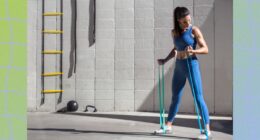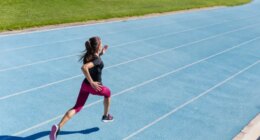When you buy your heels, flats, or sandals, you always choose a 7. So wouldn’t that hold true for your running shoe size, too?
Not exactly, Alicia Canzanese, DPM, ATC, a board-certified podiatrist, athletic trainer, and former collegiate track athlete tells SELF. For the most comfortable, pain-free ride, your running shoes should actually be bigger than your regular kicks, she says. And the same applies to most other other workout shoes too, whether you’re walking, cross-training, or lifting (all except for playing soccer, where you want tighter cleats to allow better contact with the ball).
“When you’re running or exercising, you’re going to increase blood flow to the area,” Dr. Canzanese says. “There’s inherently going to be a little expansion, there’s going to be a little widening, there’s probably going to be a little bit of swelling. So you are going to need a little bit more room.”
If your running shoes are too small, you might get more blisters, corns, and calluses, in addition to toe pain and damaged toenails from your digits banging up against the ends of your shoes. And bunions—a bony bump at the base of your big-toe joint—can often ache more if they’re being squeezed by a too-small shoe, Dr. Canzanese says.
On the flip side, too-large shoes can cause problems, too. “If your heel is slipping out, that can increase your risk of getting things like Achilles tendonitis, because you’re constantly fighting the heel moving in the shoe,” she says. Or your foot may slide back and forth, which can actually cause the same types of corns, calluses, blisters, and toenail damage you can get when shoes are too small.
READ RELATED: Why Does Alcohol Make You Poop Your Brains Out the Next Day?
So you’ll likely want to choose a running shoe size that’s bigger than your street shoes—but not too much bigger that it starts to cause its own set of problems. So how many sizes up should you go?
You may have heard us reference the “half-size-up” rule here at SELF, and while that can be a good starting point, it might not always provide enough of the extra room you need. For one thing, sizing for fashion and casual shoes is far from consistent; you might wear a 7 in one brand and style, and an 8 in another, so a half-size up from 7 might not be big enough for your running shoes. In addition, “most people are wearing the wrong size in all of their shoes,” Dr. Canzanese says. Frequently, patients will come to her with toe pain or other problems, and she’ll quickly identify overly snug footwear in general as the problem.
So instead of relying on your regular-shoe size to get the right fit, Dr. Canzanese recommends having your feet measured at a shoe store. Even if you’ve done it before, it’s worth revisiting every few years, because your shoe size can change as you age.
Once you reach adulthood, “your bones aren’t growing anymore, but there are 33 joints and 26 bones in each foot, so all of those things can flatten and shift and move,” Dr. Canzanese says. Injuries can influence this process, as can being pregnant—a hormone called relaxin makes your ligaments more elastic to allow for childbirth, and the resulting changes in your feet can be permanent (Dr. Canzanese herself went up from a 10.5 regular to an 11 wide after having kids).





